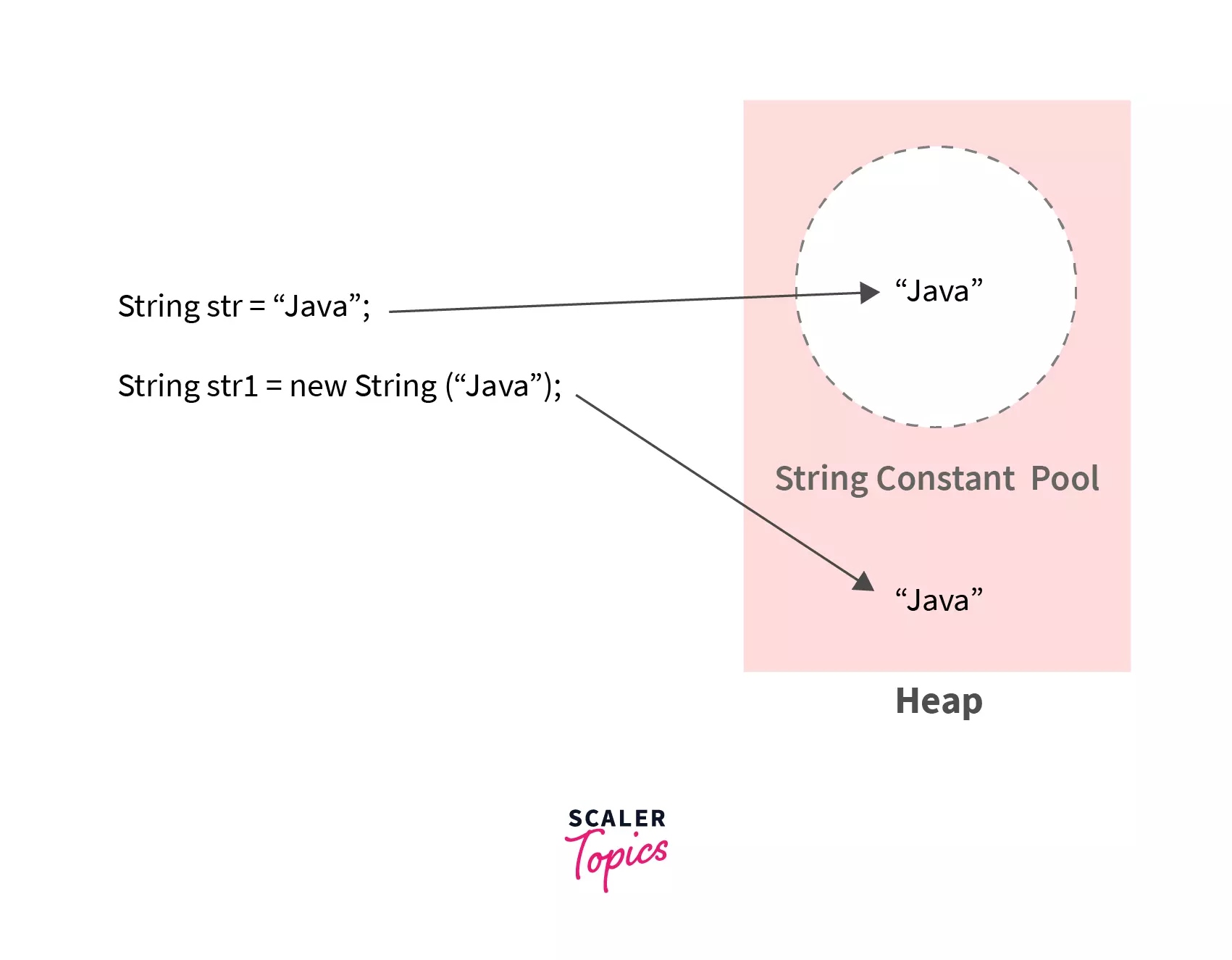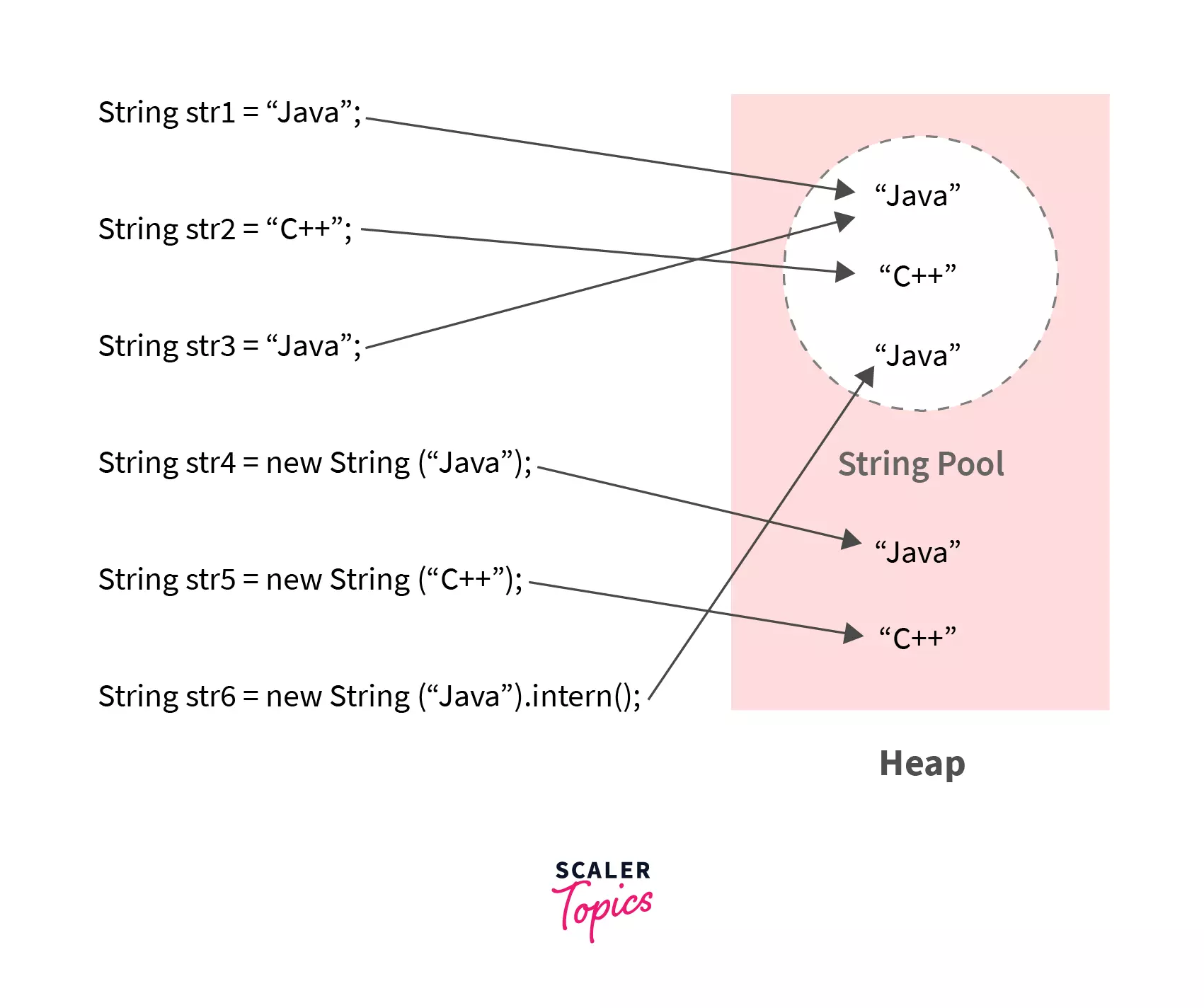Tóm Tắt
Overview
String pool is a storage space in the Java heap memory where string literals are stored. It is also known as String Constant Pool or String Intern Pool. It is privately maintained by the Java String class. By default, the String pool is empty.
A pool of strings decreases the number of String objects created in the JVM, thereby reducing memory load and improving performance.
Scope
The article aims to:
- Help understand the concept and need of String Constant Pool in Java
- Explain changes in the String Pool as a result of creating new strings using the
new
keyword and
String.intern()
method
- Discuss the advantages and disadvantages of String Pool in Java
Introduction
A string in Java is a set of characters which is always enclosed in double quotes. A string can also be described alternatively as an array of characters. But in addition, strings in Java are treated as objects.
Strings are immutable in nature. Immutable means they have a constant value, and even if they are altered, instead of reflecting the alterations in the original string, a new object is created. This immutability is achieved through String Pool. Let us look at the concept of String Pool.
What is String Pool in Java?
String Pool in Java is a special storage space in Java Heap memory where string literals are stored. It is also known by the names – String Constant Pool or String Intern Pool. Whenever a string literal is created, the JVM first checks the String Constant Pool before creating a new String object corresponding to it.
Let us first discuss the memory allocation methods used in Java – Stack Memory Allocation and Heap Memory Allocation.
- In stack memory, only the primitive data types like-
int
,
char
,
byte
,
short
,
boolean
,
long
,
float
and
double
are stored.
- Whereas, in the heap memory,
non-primitive data types
like strings are stored. A reference to this location is held by the stack memory.
Example:
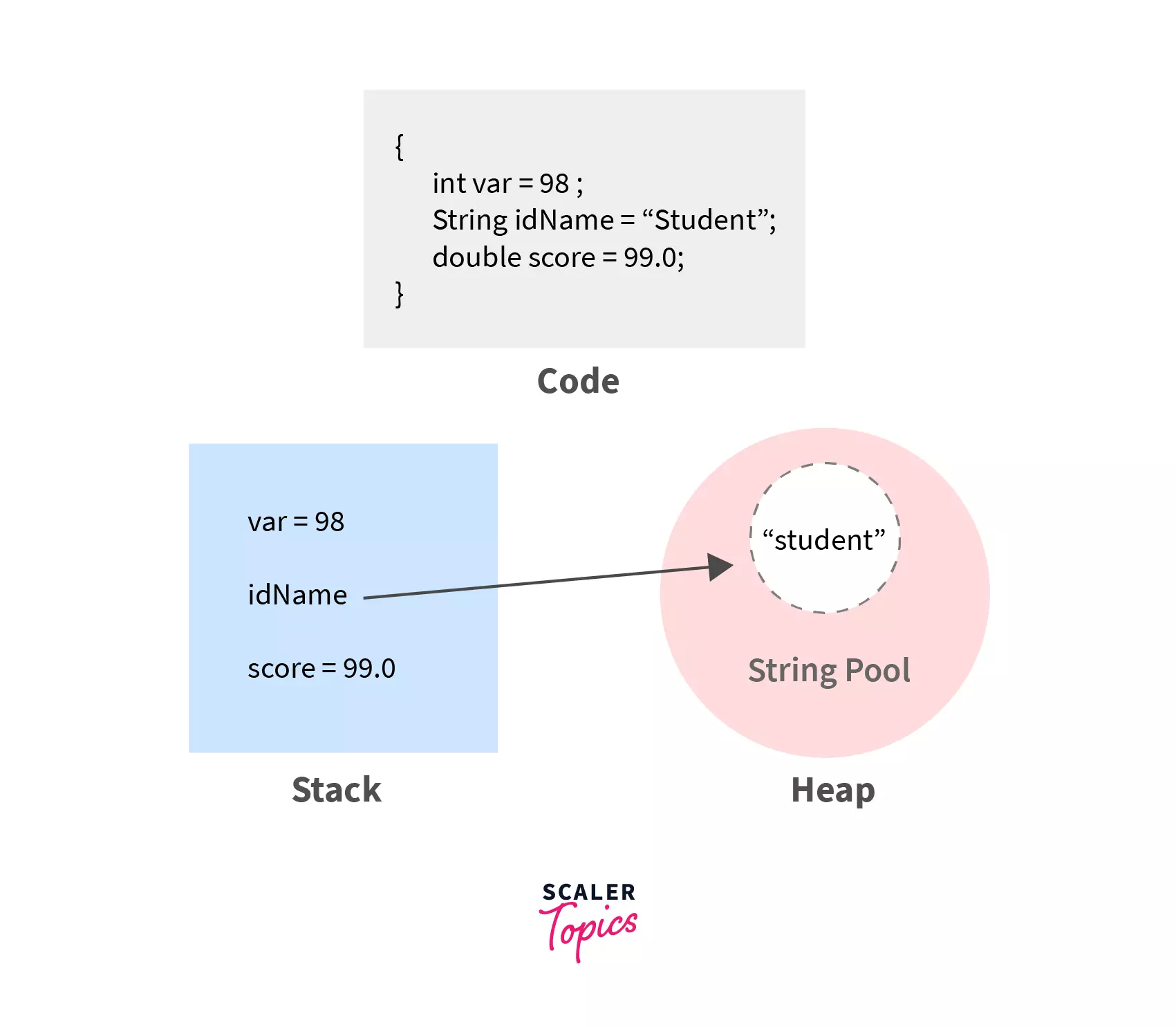
Explanation:
- Since
int
and
double
are primitive data types, they are stored in the stack memory itself.
- However,
idName
stores a String that is non-primitive in nature. Hence, the String object is created in the heap memory, and its reference is stored by
idName
in the stack memory.
Memory Allocation in the String Pool
- The String Pool is empty by default, and it is maintained privately by the String class.
- When we create a string literal, the JVM first checks that literal in the String Constant Pool. If the literal is already present in the pool, its reference is stored in the variable.
- However, if the string literal is not found, the JVM creates a new string object in the String Constant Pool and returns its reference.
Need of String Constant Pool:
- When we create a String object, it uses some amount of space in the heap memory.
- Let’s say we are creating
n
number of String objects with the same value, and distinct memory is allocated to each of these string objects (though they all contain the same string).
- This is an inefficient usage of heap memory. In order to escalate the performance of our code and reduce memory usage, JVM optimizes the way in which strings are stored with the help of a string constant pool.
Ways to Create Strings
There are three popular ways of creating strings in Java:
- String literal
- Using new keyword
- Using String.intern() method
Let us understand each of these three methods and their impact on the String Pool.
1. String literal
This is the simplest and most direct way to declare a string. It is done using double quotes.
Syntax:
String <variable name> = “<value of string>”;
Example:
String str =
"Java"
;
String str1 =
"Java"
;
String str2 =
"Study"
;
Changes in the String Pool:
- The String Pool is empty by default. Hence, when the compiler executes the first line, it creates a string literal
“Java”
in the String Constant Pool.
- When the compiler executes the second line, it first checks the String Constant Pool. Since the string literal
“Java”
is already present in the String Pool, its reference is stored in
str1
.
- As a result of the execution of the third statement, a new string literal
“Study”
is created in the String Constant Pool (since it is not already present). Its reference is stored in
str2
.
The figure shows the memory allocation of the above code.
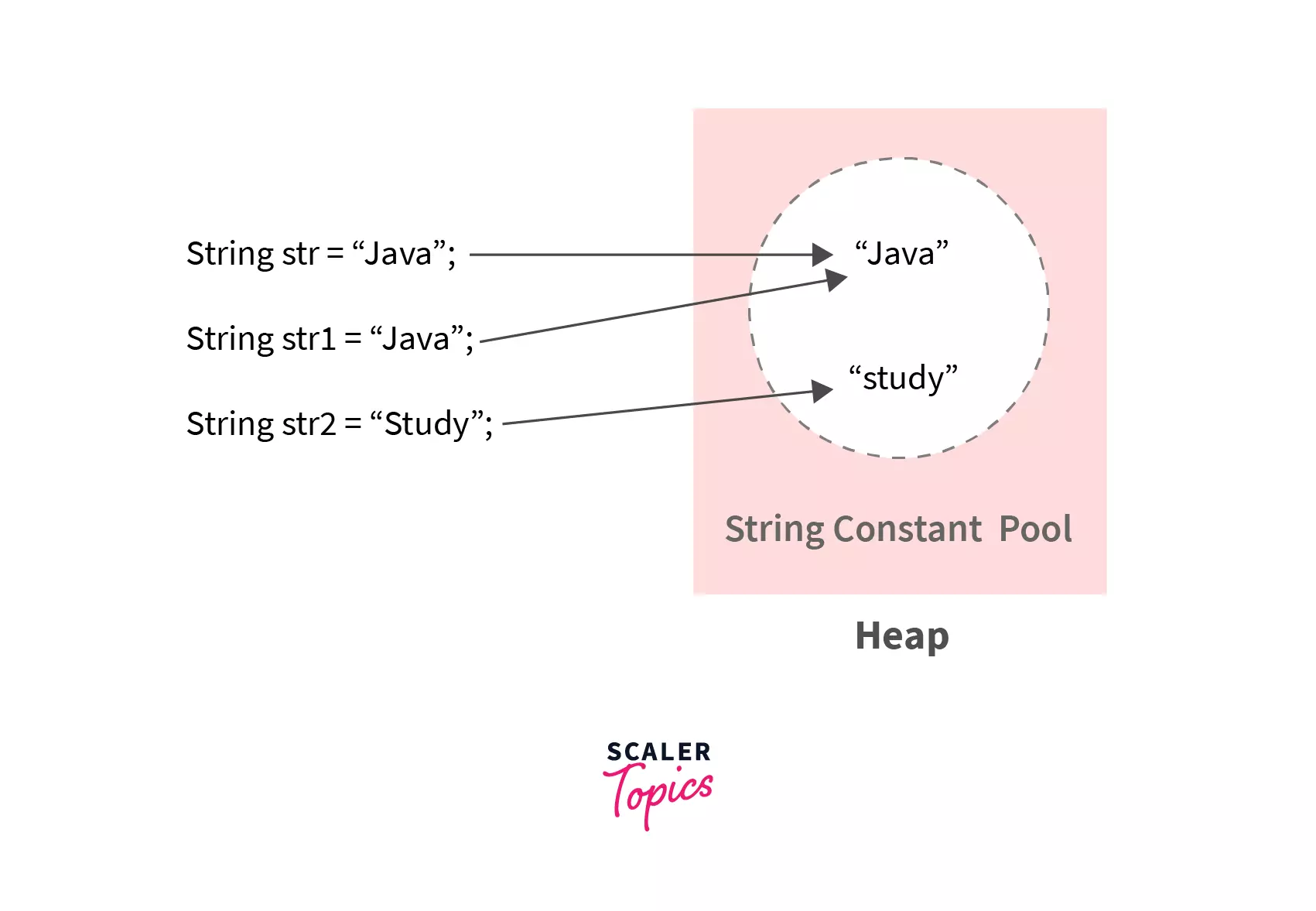
Whenever a string literal is created, the compiler checks the String Constant Pool first. If it encounters the same string, then instead of creating a new string, it returns the same instance of the existing string to the variable.
2. Using new keyword
We can create new String objects using the new keyword. When we create new string literals using the new keyword, memory is allocated to those String objects in the Java heap memory outside the String Pool.
Syntax:
String <variable name> =
new
String(“<value of the string>”);
Example:
String str =
"Java"
;
String str1 =
new
String(
"Java"
);
Changes in the Java heap memory:
The first string gets stored in the String Constant Pool, but the second string object gets stored out of the string pool in the Java heap memory.
Here is the memory representation of the same.
However, we can stop this kind of memory allocation to String objects using the String.intern() method in Java.
3. Using String.intern() method
Creating strings using the new keyword allocates memory to the string object in the heap but outside the string constant pool. When we use the String.intern() method, JVM puts the string literal in the String Pool (if not already present), and its reference is stored in the variable. However, if the String Constant Pool already contains a string equal to the String object to be created, its reference is returned.
Syntax:
<String name>.intern();
or
String <variable name> =
new
String(<
"string value"
>).intern();
Example:
String str =
"Java"
;
String str1 =
new
String(
"Java"
).intern();
String str2 =
new
String(
"Code"
);
str2.intern();
Explanation:
- The first statement creates a new string literal in the String Constant Pool.
- The second variable
str1
holds a reference of the already existing
“Java”
literal in the String Constant Pool.
- The third statement creates a new string literal in the String Pool as
“Code”
is not initially present.
The following figure illustrates the memory allocation for the same-
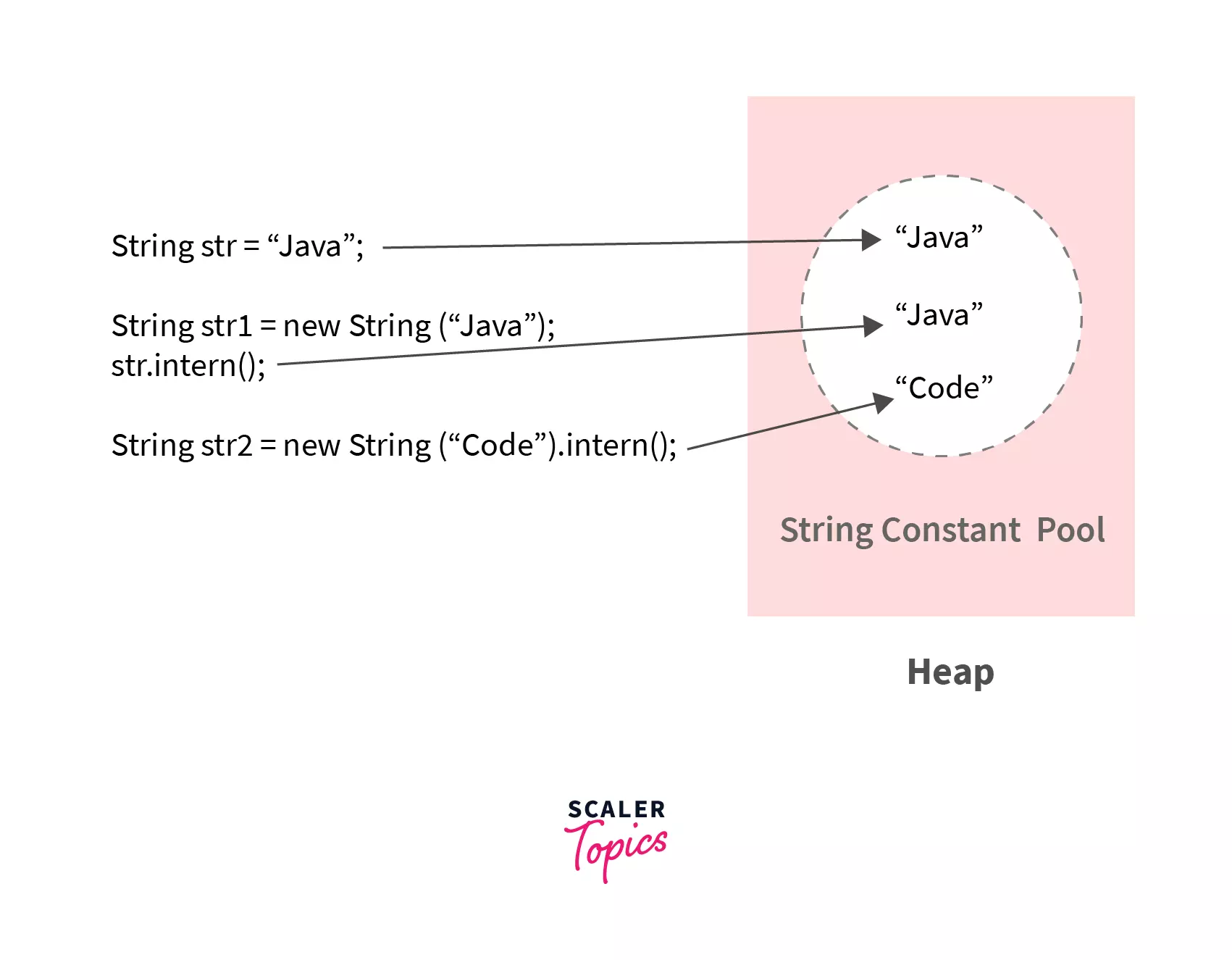
Note:
For any two strings say str1 and str2, str1.intern() = = str2.intern() will be true if and only if the statement str1.equals(str2) will be true.
String Pool in Java Flow Diagram
Let us understand the working of a string pool with a basic diagram.
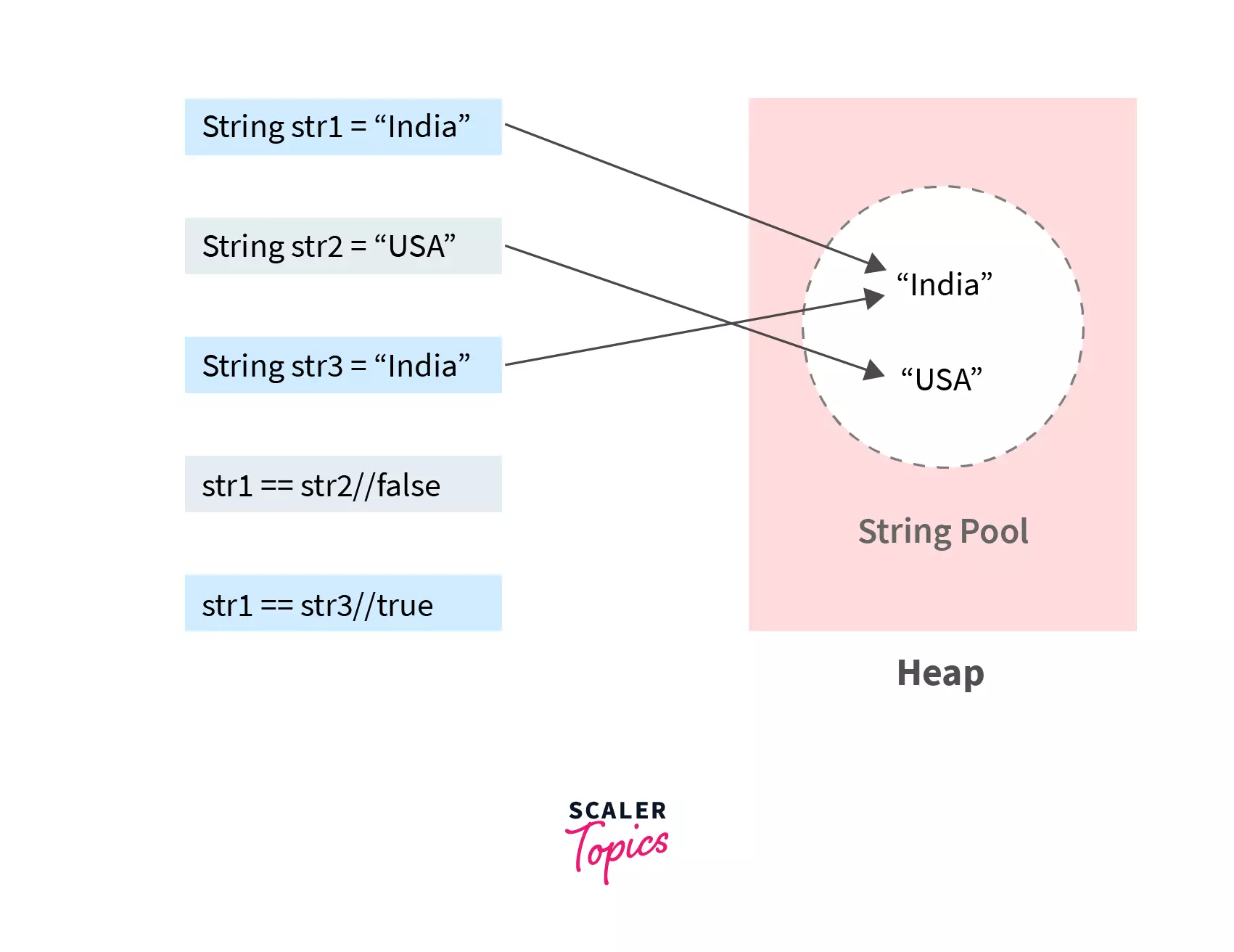
Explanation:
- The first statement creates a new string in the String Constant Pool, and
str1
holds its reference.
- The Second statement executes in a similar fashion, and variable
str2
holds the reference of
“USA”
from String Constant Pool.
- String
str3
has the same value as
str1
, and both variables hold the reference of the same String object stored in the String Pool.
-
== operator
is used to compare the addresses of the objects and check whether they refer to the same instance.
- Here, since
str1
and
str2
are two different strings or objects, after comparing them with the
==
operator, it returns
false
.
- Whereas, when
str1
and str3 are compared using the
==
operator, it returns
true
since it is referring to the same object.
Example of String Pool in Java
public
class
StringPoolExample
{
public
static
void
main
(String args[])
{
// These strings are created in the String Pool
String str1 =
"Java"
;
String str2 =
"C++"
;
// JVM returns the reference of the pooled instance, i.e., str1
// str3 will not be created in the string pool
String str3 =
"Java"
;
// stored in Java heap memory outside the String Pool
String str4 =
new
String(
"Java"
);
String str5 =
new
String(
"C++"
);
// str6 it will not get stored in the Java heap
// it will hold reference of the already-existing String object with the value "Java"
// in the String Constant Pool
String str6 =
new
String(
"Java"
).intern();
// false
System.out.println(str1 == str4);
// false
//str2 occupies space in the string pool, and str7 occupies space in the Java heap
System.out.println(str2 == str5);
// true
// address of both strings are the same
System.out.println(str1 == str3);
// true
// address of both strings are the same
System.out.println(str1 == str6); } }
Output:
false
false
true
true
Explanation:
Let us look at the figure which illustrates the memory allocation used in the program above.
Advantages of String Pool in Java
- Java String Pool allows caching of string. Caching here is the process of storing data in a cache. Cache improves performance and reduces memory usage.
- Provides reusability: It saves time to create a new string if there is already a string with the same value present in the pool. The old string is reused, and its reference is returned.
Note:
String interning is a method of storing only one copy of each distinct string value, which must be immutable. In Java, String interning is achieved using the concept of String Pool.
Disadvantages of Using String Objects
- Strings have a constant value, and even if they are altered, instead of reflecting the changes in the original string, a new object is created.
- This causes a lot of objects to be created in the heap and wastes a lot of memory if the user keeps on updating the value of the string.
Note:
In order to overcome the drawbacks of the String class, Java provides StringBuffer and StringBuilder classes. They are used to create mutable String objects.
FAQs
1. What is meant by String Pool in Java?
String Pool in Java is a storage space in Java Heap memory where unique string literals are stored.
2. Where is the String Pool stored?
String Pool is stored in the Heap Memory.
3. Why do we need String Pool in Java?
It is created to decrease the number of string objects created in the memory. Whenever a new string is created, JVM first checks the string pool. If it encounters the same string, then instead of creating a new string, it returns a reference existing string to the variable.
4. Does string pool make Java more memory efficient?
Yes, a string pool helps to save memory by preserving immutable strings in a pool so that the instances can be reused.
Conclusion
- A string is a set of characters that are always enclosed in double-quotes.
- Strings in Java are
immutable
in nature.
- This immutability is achieved through
String Pool
.
- String Pool in Java is a
special storage
space in Java heap memory. It is also known as String Constant Pool or String Intern Pool.
- Whenever a new string is created, JVM first checks the string pool. If it encounters the same string, then instead of creating a new string, it returns the same instance of the found string to the variable.
- The
String.intern()
method puts the string in the String pool or refers to another String object from the string pool having the same value.
- String Interning is a method that stores only a copy of each distinct string literal. String Pool is an implementation of the concept of String Interning.
- Java String Pool allows caching of string and reusability.
